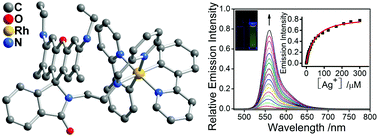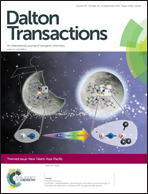Introduction of luminescent rhenium(i), ruthenium(ii), iridium(iii) and rhodium(iii) systems into rhodamine-tethered ligands for the construction of bichromophoric chemosensors†
Abstract
Several classes of luminescent transition metal complexes, including rhenium(I) tricarbonyl diimine, ruthenium(II) diimine, cyclometallated iridium(III) and rhodium(III) diimine, as well as ruthenium(II) and iridium(III) terpyridine systems, tethered with rhodamine moieties, have been synthesized and characterized. The X-ray crystal structure of one cyclometallated rhodium(III) diimine (11) with a rhodamine pendant was determined. Most of the complexes were found to exhibit emission in fluid solution at room temperature. Depending on the nature of the transition metal system, the emission origin was mainly assigned to be derived from the triplet excited state of the metal-to-ligand charge transfer (3MLCT) or the intraligand (3IL) transition. The cation-binding properties of these complexes toward various cations were investigated by electronic absorption and emission spectroscopy. Some of them were found to exhibit new low-energy absorption and emission bands, attributed to the ring opening of the rhodamine moiety, with high selectivity and/or high sensitivity for various cations, in agreement with sensing and spectroscopic behaviours of the rhodamine derivative. Depending on the nature of the transition metal centres, the chelating ligands as well as the linker to the rhodamine derivative, different sensing properties in terms of selectivity, sensitivity and binding stability, could be obtained.

- This article is part of the themed collection: New Talent: Asia-Pacific

 Please wait while we load your content...
Please wait while we load your content...